and historical purposes, all rights reserved.
This page is copyright© by
This page may not be sold or distributed without
the expressed permission of the producer.
On-line camera manual library
PRAKTICA Super TL 1000
This camera manual library is for reference
and historical purposes, all rights reserved.
This page is copyright© by ![]() , M. Butkus, NJ.
, M. Butkus, NJ.
This page may not be sold or distributed without
the expressed permission of the producer.
On-line camera manual library
If you find this manual useful,
how about a donation of $3 to:
M.
Butkus, 29 Lake Ave.,
High Bridge, NJ 08829-1701
and send your e-mail address
so I can thank you.
Most
other places would charge
you $7.50 for a electronic copy
or $18.00 for a hard to read Xerox copy.

Click here for Camera Manual site
CLICK HERE FOR A Praktica Super 1000 PDF
VERSION OF THIS HTML PAGE


We wish you all success with this modern reflex camera. You own a camera with the novel metal-blade focal-plane shutter which makes it possible to obtain maximum shutter speed stability and minimum synchronization time for electronic flash photography. The camera works on the through-the-lens light metering system with the shutter speed, diaphragm number, and film speed being coupled. Metering is according to the center-weighted LC method and fully true to your motif. Before you start snapping away happily will you please read these instructions for use carefully. You will avoid trouble with the camera and disappointments with the pictures.
Control Parts of the PRAKTICA super TL 1000
1. Shutter speed dial
2. Metering key
3. Shutter release with cable release socket
4. Folding rewind crank
5. Rewind button
6. Accessory shoe with flash center contact

7. Shutter speed mark
8. Rapid wind lever
9. Exposure counter
10. Film speed mark

11. Film speed dials
12. Diaphragm operation selection switch
13. Distance setting ring
14. Depth-of-field scale
15. Diaphragm ring
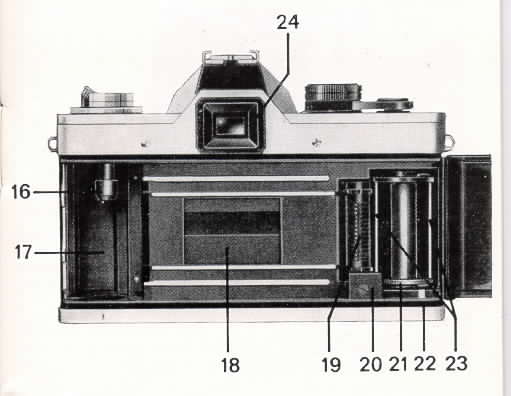
16. Rewind catch
17. Cartridge chamber
18. Metal-blade focal-plane shutter
19. Filth sprocket
20. Support
21. Take-up spool
22. Film loading mark

23. Wire brackets
24. Eyepiece mount with accessory holder
25. Rewind release
26. Battery compartment with battery inserted
27. Tripod thread
Opening the camera back
Pull rewind button (5) up to the stop, the back is unlocked and is hinged open. The exposure counter (9) resets to zero automatically

Film loading
Insert the cartridge and observe that wire brackets (23) do not stand upwards. Turn at the knurled spool disk, if required. Pull the film leader to the green mark (22) and pass it under support (20) so that the teeth of film sprocket (19) engage in the film perforation.
 |
 |
Should the film be heavily warped, put a wire bracket on it by turning the spool disk. Push rewind button (5) in again by turning it a little, if necessary.
Closing the back
The back locks automatically when you press it to the camera body at the latch side.

Setting and winding the shutter
Rapid wind lever (8) has a dead stroke of about 15 deg. till the mechanism engages. (This makes for safety at series exposures.) Swivel lever (8) to the stop, move it back and release the camera by depressing the shutter release (3). Repeat the process and finish up by winding the camera. The automatic exposure counter (9) will now read exposure 1.
(webmaster: All 35mm manual load camera lose 2 frames due to the loading system. Point and shoot and other models many not waste this "leader" and that's why they may get 2 or 3 extra shots from a roll)
 |
 |
Film speed setting
Automatic control demands setting of the film speed. Pull the knurled ring of the shutter speed dial (1) up and turn it till the DIN or ASA film index on dial (11) meets the white mark (10). The ring locks at the desired value when released.
(Webmaster: you must do this for each roll of film if different speed is used. This controls the exposure meter, so not making this change will make your negatives too dark or too light.)

Shutter speed setting
Symbol ![]() for electronic flash photography (about 1/l25 sec)
for electronic flash photography (about 1/l25 sec)
Setting B for time exposures; the shutter remains open as long as the shutter release is pressed
1 see to 1/15 sec (orange) for low light photography; a tripod is required
1/30 sec to (white) for satisfactory light photography 1/l000 sec
 0
0
Turn shutter speed dial (1) till the desired speed matches the orange triangle. (Webmaster: currently the photo show the camera set to 1/30 sec.)
Diaphragm setting
Set the desired diaphragm number on diaphragm ring (15) of the lens opposite to the mark on the lens mount. When lenses with automatic pressure diaphragm (ADB) are used, the diaphragm remains fully open and closes to the set value only when the shutter release is pressed. As soon as the shutter has finished running down, the diaphragm opens again.

Depth-of-field can be checked already on the viewfinder image when the diaphragm operation selection switch (12) is turned from A (automatic) to M (manual), or by actuating the metering key (2).
Automatic exposure control system
There are two modes of light metering to apply:
2. Metering by altering the shutter speed and pre-selected diaphragm number (recommended for low light photography with a certain depth-of-field required). (Webmaster: This is called Shutter Priority)
Set the shutter speed, press metering key (2) and turn diaphragm ring (15) till the pointer visible in the viewfinder is centered in the circular mark. Overexposure is indicated with the pointer resting in the ( + ) range while underexposure is indicated in the ( - ) range. Turning of the ring opens or closes the diaphragm accordingly for balancing object brightness with the combination of shutter speed, diaphragm opening and ASA/DIN film speed.
Metering at pre-selected diaphragm number
Set the diaphragm number, press metering key (2) and turn shutter speed dial (1) till the pointer visible in the viewfinder is centered in the circular mark. Overexposure is indicated with the pointer resting in the ( + ) range, while underexposure is indicated in the ( — ) range. Do not try to set any intermediate shutter speed between the indexed positions. Should you not succeed in attaining a perfect balance, you can make a precise correction by turning the diaphragm ring (which may, of course, may be set to intermediate values, too).
Metering with lenses without automatic diaphragm
Lenses of this kind are used in the following way: Set the diaphragm to its smallest diaphragm number, focus the lens and balance the system by stopping down.

Range of the automatic exposure control system
Outside the range (given in the below Table) the metering system is ineffective and the pointer is in its rest position below the circular mark in the " - " range. Metering cannot be made with the shutter set to "B" or symbol ![]() .
.

1. Signal
2. Image brightening Fresnel lens
3. Circular ground glass area
4. Pair of metering wedges
5. Microprism screen
6. Meter needle with circular mark
Focusing
Focusing is possible as to metering wedges, the microprism screen, or the circular ground glass area.
Focusing with the metering wedges
Turn the distance setting ring until definite outlines of the picture fractions are correctly opposed to one another.

Focusing on the microprism screen
Maximum sharpness is attained when the image in the microprism screen area is clear and does not flicker.
Circular ground glass area
Turn the distance setting ring of the lens mount until the image appears clear and distinct within the ground glass field. This is the method to choose in macro and microphotography and when using lenses with a relatively small aperture (diaphragm value higher than F4).
Depth-of-field scale
The depth-of-field covered by a certain diaphragm setting can be read on scale (14).
Example: Distance 3 meters, diaphragm number F8 depth-of-field extends from 2 meters to 5 meters.

Infrared photos require a slight correction of the focus; let the determined distance meet the infrared mark on the lens.
Releasing and winding
Please note before pressing the shutter release:
2. For shutter speeds of 1/15 seconds and slower use a tripod and a cable release. Press shutter release (3) smoothly but not suddenly right across the easy going section. Swivel the lever again for winding after exposure.

Observe the exposure counter for the number of pictures you can take with the film in your camera (12, 24 or 36 exposures). After the last exposure, press rewind release (25) (it locks), tilt the folding rewind crank (4) out of rewind button (5) and turn it not too fast in the direction of the arrow (indicated on the crank (4). You will feel the end of rewinding by a somewhat increased resistance with subsequent easy running. Pull the rewind button up to the stop, unlock the camera back and take the cartridge.
 |
 |
Lens changing
Any lenses having the international M 42x1 PRAKTICA thread (Webmaster: Pentax thread mount) can be used. Grip the lens body and unscrew in counter-clockwise direction; screw in the other lens in clockwise direction to the stop.
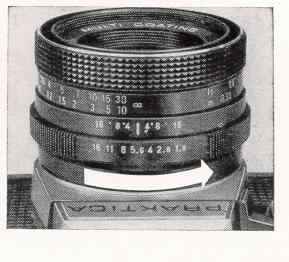
Flash photography
The PRAKTICA super TL 1000 has been designed for synchronization of flashbulbs and electronic flash units. Flash units provided with a center contact are pushed into accessory shoe (6). Set the shutter speed dial either to :g or f.
The firing circuit is closed only during the period of the shutter running down. Observe the guide number of the flash unit and make the aperture or distance calculation (use the calculator disk of the flash unit).
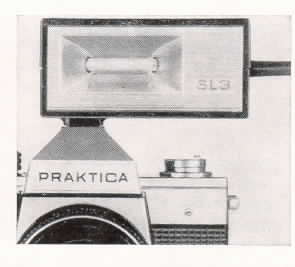
(Webmaster: most current flash units are "automatic", you set the camera to it's "flash" or "sync" speed, which on this camera is 1/100 sec. [ most are 1/60 ], check the back of the flash unit you will use and it will have a chart. Depending on the ASA of the film the flash will show an F-stop to set the lens diaphragm to. The flash will also show you the range in distance you can photograph. This is usually 4 feet to some 15 feet or more. Some flash units have two or three F-stops to choose from. Depending on the power (size) of the flash, that determines the F-stop and longest distance from your subject.)
The use of flashbulbs
For fast burning flashbulbs the speed dial is set to the symbol or to a shutter speed longer than 1/30 sec.
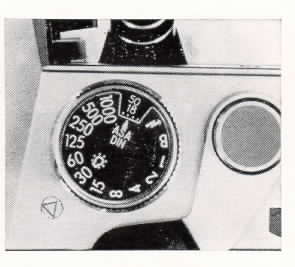
The use of electronic units Synchronization is only at the symbol ![]() which corresponds to a shutter speed of about 1/125 sec.
which corresponds to a shutter speed of about 1/125 sec.
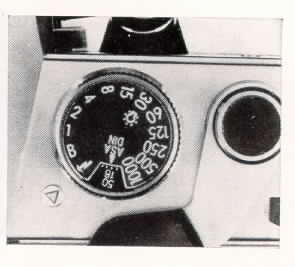
Battery replacement
The automatic exposure control system is powered by a mercury oxide battery type PX 625 or another type meeting the same specification, of a rated voltage of 1.35 V.
(Webmaster: this is a mercury battery, not available for sale in the U.S. Check my web page for Mercury Battery Replacements. There are several options.
Unscrew the cover of the battery compartment (26) with a coin, note the plus (+) and minus ( - ) marks, insert the battery correctly and screw the cover of the battery compartment in again. Battery service life is about 2 years.
Do not try to charge the battery or put it into the fire - it might blow up!
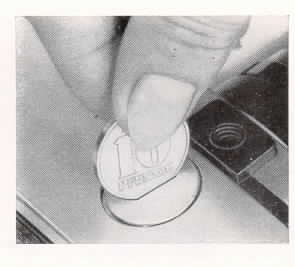
Care of the camera
Operation according to instructions and proper care are essential preconditions for trouble free function of this precision instrument. Protect it from shocks, blows, dust and moisture; clean cartridge and spool compartments, film track and camera back with a soft brush in suitable intervals. Do not excert any pressure onto the shutter blades and do not touch them with your fingers. Dust the mirror with a soft brush only if absolutely necessary. Clean the battery contact ends in intervals of 6 months and remove the battery from the camera when not required for at long time. We recommend you protect the camera in cold weather. When not used, shut the eyepiece by means of the delivered protective cap.
The PRAKTICA super TL 1000 is available with various lenses.
Please observe the recommendations contained in this booklet. Handling the camera carelessly or contrary to instructions may lead to damages which, we regret to say, are not covered by our guarantee.
Our consistent efforts to improve our products may lead to some slight deviations of the PRAKTICA super TL 1000 from the present details.